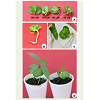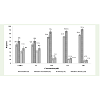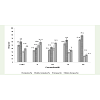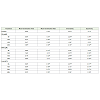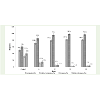Effect of Temperature and Plant Growth Regulators on Seed Germination Response ofOroxylum indicum-A High Value Threatened Medicinal Plant of Sikkim Himalaya
Mithilesh Singh* K.K. Singh, Hemant K. Badola
Corresponding author: Dr. Mithilesh Singh, G.B. Pant Institute of Himalayan Environment and Development, Sikkim Unit,Pangthang, Gangtok, Sikkim-737101, India, Tel: 03592-237328/237189, Fax: 03592-237415; E-mail: singmithilesh@gmail.com
G.B. Pant Institute of Himalayan Environment and Development, Sikkim Unit, Pangthang, Gangtok, Sikkim-737101, India
Citation: Singh M, Singh KK, Badola HK. Effect of Temperature and Plant Growth Regulators on Seed Germination Response of Oroxylum indicum-A High Value Threatened Medicinal Plant of Sikkim Himalaya. J Plant Sci Res. 2014;1(4): 115.
Copyright © 2014 Mithilesh Singh et al. This is an open access article distributed under the Creative Commons Attribution License, which permits unrestricted use, distribution, and reproduction in any medium, provided the original work is properly cited.
Journal of Plant Science & Research | ISSN: 2349-2805 | Volume: 1, Issue: 4
Submission: 13/11/2014; Accepted: 02/01/2015; Published: 09/01/2015
Reviewed & Approved by: Dr. N. Mathivanan, Associate Professor, Centre for Advanced Studies in Botany, University of Madras, India
Abstract
Oroxylum indicum is an integral component of Indian Ayurvedic medicine system. Owing to depletion of its natural populations, the plant is facing threats of extinction. Different plant growth regulators (viz. Benzyl amino purine, Indole-3-acetic acid, Gibberellic acid) andtemperatures (cold and hot water) were used to improve seed germination in O. indicum. Cold water treatment had significantly improved the seed germination as compared to control, hot water treatment and tested plant growth regulators. Cold water at 4 °C for 24h was found to be optimum, which resulted in to more than 80% seed germination response. Here, it is the first time we have described the seed germination requirement of Oroxylum indicum, using growth hormones and temperatures. The study suggested that the seed germination and seedling growth of Oroxylum can be improved by using simple and economic method.
Keywords: Conservation; Oroxylum indicum; Seed Germination; Stress
Abbreviation: BAP-Benzyl amino purine; IAA-Indole-3-Acetic Acid; GA3-Gibberellic acid
Introduction
Oroxylum indicum (L), commonly known as Sonapatha, Shyonaka or tatola, is an important medicinal plant of the family Bignoniaceae. This high value multipurpose tree is reported to be vulnerable in Sikkim Himalaya [1]. Different parts of the plant, particularly leaves, bark and root have been extensively used in Indian System of Medicine [2]. Its root is an important constituent of Dashmula which is a compound decoction of 10 roots [3]. Plant is also included in famous tonic formulations, such as Chyawanprash. O. indicum is reported to have anticancer, antioxidant, hepatoprotective and immunomodulaory properties [4-6]. In addition, Oroxylum has antibacterial, analgesic and gastro-protective properties [7,8]. These properties are mainly due the presence of diverse range of phytocompounds in the plant. Major medicinally important bioactive compounds present in this species are baicalein, oroxylin A, chrysin and its derivatives [9,10].
At present, the entire commercial requirement of O. indicum is met solely from the wild natural populations. The species is generally propagated by seeds but its germination rate and viability is very low due to seed abortion [11,12]. Destructive and non-sustainable collection methods coupled with low regeneration and habitat destruction have posed serious threats to the survival and availability of O. indicum [13]. To keep pace with the growing demand of this tree, its propagation by conventional and biotechnological method is highly warranted. In the present study, to obtain rapid, uniform and high seed germination response of O. indicum, different presowing treatments were performed. Specifically, we studied the pretreatment effect of temperature (hot and cold water) and plant growth regulators on Oroxylum seed germination response and established a suitable method to overcome its low and erratic germination rate.
Materials and Methods
Collection of material
Mature fruits of O. indicum were collected in October 2013 from a mother plant growing in natural habitat in Asam-Lingzay, East Sikkim (ca. 1000 m a.s.l.). The fruits were washed thoroughly under running tap water to remove the surface contaminants. After proper drying at room temperature, the fruits were split open to collect seeds.
Seed viability test
To ensure that the seeds used for the experiment were viable and of high quality; viability test using the tetrazolium chloride technique was performed. Three replicates of 24 seeds each were used. Using the procedure described by Peters [14], the seeds were imbibed for 24 h in water, cut along the margin without damaging the embryo and soaked in colourless 0.1% solution of 2,3,5-triphenyltetrazolium chloride (TTC) solution for 24 h at 25 °C in the dark. The seeds were removed from TTC solution and washed with distilled water, and viewed under a light microscope to observe the stained embryos. Whole embryos of viable seeds appeared bright red in colour. Seed viability was observed immediately at the time of collection and after 3 and 6 months of storage at normal room temperature.
Effect of seed wing and sulphuric acid (H2SO4)
To investigate the effect of wing on seed germination, experiments were conducted using seeds with wings and without wings. To overcome seed epicarp dormancy if any, seeds were given pre-sowing H2SO4 treatments. Seeds were immersed in 96% sulphuric acid for 30 sec, and then rinsed thoroughly in running water for 45 min.
Effects of plant growth regulators
The effects of three plant growth regulators viz. Gibberellic acid (GA3), Benzylamino purine (BAP) and Indole 3-acetic acid (IAA) at 50, 100, 150 and 200 μM concentrations were tested for O. indicum seed germination in a controlled environment system. Twenty four seeds of uniform size were immersed in different concentrations of three plant growth regulators for 24 h, distilled water used for control treatment. Seeds were then rinsed with distilled water and placed in Petri dishes on filter paper. Petri dishes were watered with distilled water, as needed, to ensure adequate moisture for seed germination. The incubation temperature was 25 °C. All the seeds were checked daily for germination during 30 days.
Temperature treatments
Based on literature, the following pre-sowing temperature treatments were used to establish methods for overcoming seed dormancy: cool water (soaking in water at 4 °C for 6, 12, 24 and 48h), hot water (soaking in boiling water for 30, 60, 90 and 120 s). All the results were compared with control.
Seed germination conditions
Each germination treatment, including control, was performed with three replications. In each replicate, 24 seeds were used, giving a total of 72 seeds in each pre-sowing treatment. The Petri dishes were placed in a seed germination chamber at 25± 2 °C, with alternating light (14/10 h photoperiod). The seeds were kept moist (using DDW) and checked every day. Visible protrusion of the radical was the criterion to score seed germination. Final observation on the percentage germination, percentage relative germination, percentage dormancy, percentage relative dormancy and seedling morphologywere taken after 30 day.
Statistical analysis
Results were analyzed using analysis of variance (ANOVA) and significance was determined at p < 0.05. The data was analyzed statistically using SPSS (version 16) software and significant differences among the mean values were assessed on the basis of the Duncan’s multiple range test. In graph, data represented as mean ± standard deviation. The following parameters were determined:
Germination = number of germinating seeds/ number of seeds initiated × 100
Relative germination = number of germinating seeds/number ofviable seeds initiated × 100
Dormancy = number of ungerminated seeds but viable seeds/number of seeds initiated × 100
Relative dormancy = number of ungerminated seeds but viableseeds/number of viable seeds initiated × 100
Mean germination time (MGT), mean germination rate (MGR), uncertainty of germination and synchrony of germination were calculated by following Ranal et al. [15].
Results
Seed viability
Seed viability significantly decreased with duration. At the time of seed collection 83.33% seeds were viable. After 3 months of storage at room temperature, seed viability was decreased to 62.5% (p < 0.05),and after 6 months storage it plunged to 41.67%.
Effect of seed wing and sulphuric acid (H2SO4)
In the present study, to break the physical dormancy of seed wing and epicarp, Oroxylum seeds were subjected to dewinging and H2SO4 treatments. H2SO4 have had a corrosive physical action on Oroxylum seeds as its seed coat is very thin. Dewinging also showed poor results. The seeds with wings germinate earlier than the dewinged seeds. Moreover, in comparison to dewinged seeds, seedlings developed from winged seeds were healthy and fast growing (Figure 1a-d).
Figure 1: (A) An open pod of Oroxylum indicum showing numerous seeds;(B) Seeds of Oroxylum indicum (C&D) One-week old germinated dewinged and winged seeds of Oroxylum indicum (arrow marked).
Effect of plant growth regulators
In the present study, tested plant growth regulators have vinfluenced the seeds germination and radical length to different extent. Among the tested growth regulators, BAP was found to be highly effective to induce seed germination. At 50 μM concentration of BAP, only 50% seeds were germinated, whereas 100-200 μMconcentrations of BAP helped >70% seed germination. There was no significant (p< 0.05) difference in the percent germination from 100-200 μM BAP treatments, but BAP significantly influenced the development of radical length with increasing concentration (Figure 2a; Figure 3). At 200 μM concentration of BAP, 76.4% seeds were germinated having rudimentary roots.
Figure 2: (A) Three-week old BAP treated Oroxylum indicum seedlings showing decrease in radicle length with increase in BAP concentration.(B) Three-week old GA3 treated Oroxylum indicum seedling having long hypocotyl and rudimentary root.(C) Three-week old cold water treated Oroxylum indicum seedlings having green leaves and well developed roots and root hair.(D) Cold pretreated (left) and control (right) Oroxylum indicum plants after9 weeks
Figure 3: Effect of BAP treatment on seed germination response of Oroxylum indicum. Data are means (n =3) ± standard deviation (n = 3). Values in a column followed by different letters are significantly (p, 0.05) different according to Duncan’s test.
Effect of GA3 treatments was not found to be significant over control (Figure 4). At lower concentrations (50 and 100 μM) of GA3, significant reduction in germination percentage was observed. Nevertheless at higher GA3 concentrations (150 and 200 μM), germination percentage had increased but germinated seedlings were found to be abnormal with long hypocotyls. Moreover, GA3 treatment had caused vitrification of seedlings (Figure 2b.). Again, GA3 treatment was inhibitory to root development. Effect of IAA was found to be completely inhibitory.
Figure 4: Effect of GA3 treatment on seed germination response of Oroxylum indicum. Data are means (n =3) ± standard deviation (n = 3). Values in a column followed by different letters are significantly (p, 0.05) different according to Duncan’s test.
Results of growth regulators pre-treatments not only showed differences in the germination percentage, but also in the mean germination time, mean germination rate, uncertainty of germination, synchrony of germination and size of the seedlings (Figure 2; Table 1). In comparison to control and BAP, GA3 pre-treatments resulted in earlier and faster emergence (Table 1). Moreover, seedlings from GA3 pretreatments were bigger than seedlings from BAP treatments. Hypocotyl length had increased with the concentration of GA3. At 150 μM concentrations, the hypocotyl length was 1.92 cm in GA3treated seeds which are much longer than the 0.79 cm length fromBAP.
Table 1: Effect of GA3 treatment on seed germination response of Oroxylum indicum. Data are means (n =3) ± standard deviation (n = 3). Values in a column followed by different letters are significantly (p, 0.05) different according to Duncan’s test.
Effect of temperature
Among hot and cold water pretreatments, cold waterpretreatments significantly improved the seed germination response. Soaking Oroxylum seeds in water at 4 °C for 12, 24 and 48h resulted in a significantly (p< 0.05) higher germination percentage than 6h pre-treatment and control (Figure 5). Results indicate that cold water pre-treatments significantly reduced the mean germination time and increased the mean germination rate. The minimum mean germination time was recorded in seeds subjected to 24h cold water pre-treatment which is significantly different than 6, 12 and 48 h treatments (Table 1). Cold pre-treatments produced seedlings of significantly higher vegetative growth vigour than those of other treatments and control (Figure 2c & d).
In comparison to cold water pre-treatment, the effect of hot water on the seeds of Oroxylum gave adverse result. This shows that hot water pre-treatment is not an appropriate pre-treatment technology in the seeds of Oroxylum.
Figure 5: Effect of cold treatment on seed germination response of Oroxylum indicum. Data are means (n =3) ± standard deviation (n = 3). Values in a column followed by different letters are significantly (p, 0.05) different according to Duncan’s test.
Discussion
The propagation of plants by seeds is easy, fast and most preferred method of plant conservation because it preserves genetic variations. However, seeds of many plant species specifically trees exhibit dormancy and fail to germinate even in favourable conditions. Depending on the plant species and type of dormancy, various methods like scarification, pre-treatment with growth regulators and temperature shocks are used to break dormancy [16]. In the present study, to break Oroxylum seed dormancy, different germination experiments were carried out to investigate the effect of plant growth regulators (viz. GA3, BAP and IAA), scarification and temperature cold and hot water) on germination response of Oroxylum seeds. Despite of being a high value plant, so far, there is not much documentation on Oroxylum seed germination; therefore, much more insights are needed on this aspect for large scale propagation of this tree.
Obtaining commercially useful seedlings of economically important Oroxylum tree is hindered by innumerable factors including uneven germination, reducing seed longevity and hence viability [11,12]. The results of viability test using TTC showed that the seed viability decreased from 83.33 to 41.67 % after six months of storage at room temperature. Loss of moisture content and very low reserve of nutrients are most probably the main reasons of Oroxylum seed deterioration during storage conditions. Similar studies were carried on viability testing of the seeds using TTC in Magnolia officinalis and Panax notoginseng [17]. Viability study using TTC is very important in seed trade, crop production and also in germplasm conservation and management.
Scarification increases the seed germination rate of a number of plant species [18,19] indicating that seed outer covering impermeability to water and/or gases may be involved in the seed dormancy. However, in the present study, scarification viz. dewinging and H2SO4 showed negative effect. Dewinged seeds though germinated but their germination success was very low. Moreover, seedlings developed from dewinged seeds showed stunted growth. Seeds treated with H2SO4 did not show any response. This might be due to the presence of thin seed coat in Oroxylum as a consequence of which acid have ruptured vital parts of the embryo.
Plant seed germination is controlled by specific endogenous growth promoting and inhibiting compounds [20] and there is a strong correlation among applied hormones, hormone concentration, specific developmental stage and metabolic activities [21]. Plant growth regulators in minute quantities are known to enhance thegermination percentage and reduce the germination time. In the present study, auxin (IAA), cytokinin (BAP) and gibberelic acid (GA3) were tested at different concentrations to improve the seed germination response of Oroxylum. In comparison to control, BAP and GA3 improved seed germination at optimum concentrations. However, IAA effect was found to be inhibitory. Pre-sowing seed treatments with growth substances such as plant growth regulators have been found to improve the seedling growth of many other species [22-26].
The effect of cold pre-treatment on seed dormancy breaking has also been confirmed in some other plants such as: Capparis ovate [27], Ferula ovina [28] and Pinus roxburghii [29]. It has been reported that the promontory effect of cold treatment on seed germination might be due to increase in the level of the organic phosphates like fructose 2,6-biphosphate [30], ATP [31] and nucleotides [32]. Several scientists have confirmed this elucidation.
Conclusion
The results suggest that the seeds of Oroxylum indicum could be germinated without pre-treatment, however, to attain higher germination percentage and reduced dormancy period, the seeds should be pre-treated with cold water. Cold water treatment at 4 °C for 24h seems to be most effective method and could be easily adopted by the potential farmers for economic cultivation of this species.
Acknowledgment
The authors thank the Director of the institute for providing necessary facilities and support.
References
- Pradhan BK, Badola HK (2008) Ethnomedicinal plant use by Lepcha tribe of Dzongu valley, bordering Khangchendzonga Biosphere Reserve, in North Sikkim, India. J Ethnobiol Ethnomed 4: 22.
- Anonymous (1998) The ayurvedic pharmacopoeia of India. New Delhi, Government of India, Ministry of Health and Family Welfare, Department of Indian System of Medicine and Homeopathy 3: 209-210.
- Raghu AV, George S, Krishna VR, Sindhu KK (2013) Bioactive properties of phenolics present in Oroxylum indicum - A review. J Pharmaco Phytochem 2: 23-27.
- Chiang LC1, Ng LT, Chiang W, Chang MY, Lin CC (2003) Immunomodulatory activities of flavonoids, monoterpenoids, triterpinoids, iridoid glycosides and phenolic compounds of Plantago species. Planta Med 69: 600-604.
- Yang RY, Samson CST, Lee TC, Janhiu W, Hanson PM, et al. (2006) Distribution of 127 edible plant species for antioxidant activities by two assays. J Sci Food Agric 86: 2395-2403.
- Roy MK, Nakahara K, Na TV, Trakoonivakong G, Takenaka M, et al. (2007) Baicalein, a flavonoid extracted from a methanolic extract of Oroxylum indicum inhibits proliferation of a cancer cell line in vitro via induction of apotosis. Pharmazie 62: 149-153.
- Mat Ali R1, Houghton PJ, Raman A, Hoult JR (1998) Antimicrobial and anti-inflammatory activities of extracts and constituents of Oroxylum indicum (L.) Vent. Phytomedicine 5: 375-381.
- Zaveri M, Jain S (2010) Anti-inflammatory and analgesic activity of root bark of Oroxylum indicum Vent. J Global Pharm Technol 2: 79- 87.
- Chen LJ, Games DE, Jones J (2003) Isolation and identification of four flavonoid constituents from seeds of Oroxylum indicum using by high-speed counter-current chromatography. J Chromatogr A 988: 95-105.
- Dinda B, Mohanta BC, Arima S, Sato N, Harigaya Y (2007) Flavonoids from the stem-bark of Oroxylum indicum. Nat Prod Sci 13: 190-194.
- Dalal NV, Rai VR (2004) In vitro propagation of Oroxylum indicum Vent. A medicinally important forest tree. J For Res 9: 61-65.
- Talari S, Penchala S, Marka R, Rudroju S, Ramaswamy N (2013) Embryo culture an efficient tool for conservation of an endangered medicinally important forest tree Oroxylum indicum Kurz. Int J Biotechnol Res 3: 45-52.
- Yasodha R, Ghosh M, Santan B, Gurumurthi K (2004) Importance of biotechnological research in tree species of Dashmula. Indian For 130: 79â€88.
- Peters P (2000) Tetrazolium testing handbook. Contribution No. 29. The hand book on seed testing. Prepared by tetrazolium subcommittee of the association of official seed analysis. Part 2 Lincoln, Nebraska, USA.
- Ranal MA, Santana de DG (2006) How and why to measure the germination process? Revista Brasil Bot 29: 1-11.
- Hidayati SN, Walck JL, Merritt DJ, Turner SR, Turner DW, et al. (2012) Sympatric species of Hibbertia (Dilleniaceae) vary in dormancy break and germination requirements: implications for classifying morphophysiological dormancy in Mediterranean biomes. Ann Bot 109: 1111-1123.
- Zhou J, Kulkarni MG, Huang LQ, Guo LP, van Staden J (2012) Effects of temperature, light, nutrients and smoke-water on seed germination and seedling growth of Astragalus membranaceus, Panax notoginseng and Magnolia officinalis - highly traded Chinese medicinal plants. S Afr J Bot 79: 62-70.Anthoni J F (2006) The chemical composition of seawater.
- Amusa TO (2011) Effects of three pre-treatment techniques on dormancy and germination of seeds of Afzelia Africana (Sm. Ex pers). J Hortic For 3: 96-103.
- Dewir YH, El-Mahrouk MES, Naidoo Y (2011) Effects of some mechanical and chemical treatments on seed germination of Sabal palmetto and Thrinax morrisii palms. Aust J Crop Sci : 248-253.
- Hartmann HT, Kester DE, Davies FT, Geneve RE (1997) Plant Propagation - Principles and Practices, 6th ed, Prentice-Hall Inc., New Jersey, USA, 125-144.
- Pedroza-Manrique J, Fernandez-Lizarazo C, Suarez-Silva A (2005) Evaluation of the effect of three growth regulators in the germination of Comparettia falcata seeds under in vitro conditions. In Vitro Cell Dev Biol Plant 41: 838-843.
- Butola JS, Badola HK (2004) Effects of pre-sowing treatments on seed germination and seedling vigour in Angelica glauca, a threatened medicinal herb. Curr Sci 87: 796-799.
- Pradhan BK, Badola HK (2010a) Chemical stimulation of seed germination in ex-situ produced seeds in Swertia chirayita, a critically endangered medicinal herb. Res J Seed Sci 3: 139-149.
- Pradhan BK, Badola HK (2010b) Chemical treatments to improve seedling emergence and vigour using seeds from six ex-situ source in Swertia chirayita, a critically endangered medicinal herb in Himalaya. J Plant Bio 37: 109-118.
- Dhoran VS, Gudadhe SP (2012) Effect of plant growth regulators on seed germination and seedling vigour in Asparagus sprengeri Regelin. Int Res J Biol Sci 7: 6-10.
- Hu XW, Huang XH, Wang YR (2012) Harmonal and temperature regulations of seed dormancy and germination in Leymus chinensis. Plant Growth Regul 67: 199-207.
- Olmez Z, Gokturk A, Gulcu S (2006) Effects of cold stratification on germination rate and percentage of caper (Capparis ovata Desf.) seeds. J Environ Biol 27: 667-670.
- Amooaghaie R (2009) The effect mechanism of moist-chilling and GA3 on seed germination and subsequent seedling growth of ferula ovina boiss. Open Plant Sci J 3: 22-28.
- Ghildiyal SK, Sharma CM, Khanduri VP (2009) Effect of pre-soaking and pre-chilling treatments on seed germination of Pinus roxburghii provenances from western Himalaya India. J For Res 20: 323-330.
- Bewley JD, Black M (1994) Mobilization of stored seed reserves: seeds physiology of development and germination. Plenum Press: New York. p. 293-343.
- Noland TL, Murthy JB (1984) Changes in isocitrate lyase activity and ATP content during stratification and germination of sugar pine seeds. Seed Sci Technol 12: 777-789.
- El-Dengawy EFA (1997) Physiological and biochemical studies on seeds dormancy and germination process in deciduous fruit trees. Ph.D. Thesis. Faculty of Agriculture, Mansoura University, Egypt.


